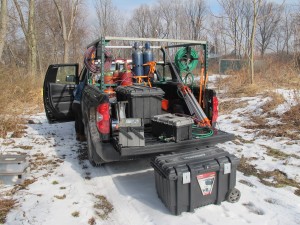A bottom up and top down approach to methane detection

Susan Phillips / StateImpact Pennsylvania
Researchers from Carnegie Mellon University use “tracers”, inert gasses, to detect methane leaks at well sites.
Scientists looking to figure out how much natural gas leaks from shale gas production sites are taking both a bottom up and top down approach. Using NOAA aircraft usually reserved for flying through hurricanes, researchers from the University of Colorado flew over shale plays in Pennsylvania, Texas, Louisiana and Arkansas to measure how much methane was escaping into the atmosphere. Their study was published last week in the Journal of Geophysical Research: Atmospheres. While flying over Northeast Pennsylvania one day in 2013, researchers detected a natural gas leak rate from the Marcellus Shale of just 0.18 to 0.41 percent of production. Those results are much lower than the researchers fly-over detections in Utah’s Uinta Basin, which were reported at 6.2 to 11.7 percent of production.
But the research is limited in that it was just one day, and emissions can vary daily as well as hourly. Writing in a post on the Environmental Defense Fund blog, EDF’s associate vice president Mark Brownstein says it’s not yet time to “pop the champagne corks.”
More robust studies that cover longer time periods actually suggest methane emissions are often higher than previously estimated. EDF’s own studies – including two released last week looking at the transmission and storage and gathering and processing sectors of the oil and gas industry – have repeatedly shown that random leaks and malfunctions are a major source of emissions.
Because these events are random, a one-day overflight will not give a full picture of emissions coming from a basin over a day, a month, or a year. What is needed is regular and ongoing monitoring.
The Environmental Protection Agency does not regulate methane as a pollutant, but recently the agency proposed to limit methane leaks from oil and gas production. The shale gas boom has put the spotlight on methane leaks because natural gas has become the fuel of choice, replacing coal fired power plants. Coal is by far the dirtiest fuel, which emits pollutants that cause asthma and lung cancer, as well as the greenhouse gas carbon dioxide. Methane burns cleaner at the power plant but if it escapes into the atmosphere, it can be a much more damaging greenhouse gas than CO2 in the short term.
Researchers at Carnegie Mellon University are gathering data about methane leaks by measuring emissions at ground level. Albert Presto is the lead researcher on the project. Presto says typically, he’s seen wells where the methane leaks are less than one percent. But then there can be very large emitters.
“The same thing happens with cars,” says Presto. “There are lots and lots of cars on the road, and once a week you might drive behind one with black smoke [streaming from the exhaust pipe.] Well, gas wells are similar.”
















